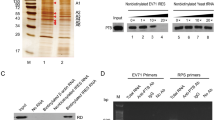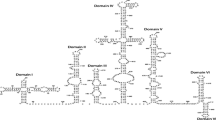Abstract
Nipah virus belongs to the genus Henipavirus in the family Paramyxoviridae, and its RNA genome is larger than those of other paramyxoviruses because it has long untranslated regions (UTRs) in each gene. However, the functions of these UTRs are not fully understood. In this study, we investigated the functions of the 5′ UTRs and found that the 5′ UTR of the M gene upregulated the translation of a reporter gene. Using an RNA pull-down assay, we showed that eukaryotic elongation factor 1-beta (EEF1B2) interacts with nucleotides 81–100 of the M 5′ UTR and specifically enhances its translation efficiency. Our results suggest that the M 5′ UTR promotes the production of M protein and viral budding by recruiting EEF1B2.




Similar content being viewed by others
References
Anderson DE, von Messling V (2008) Region between the canine distemper virus M and F genes modulates virulence by controlling fusion protein expression. J Virol 82:10510–10518
Arankalle VA, Bandyopadhyay BT, Ramdasi AY, Jadi R, Patil DR, Rahman M, Majumdar M, Banerjee PS, Hati AK, Goswami RP, Neogi DK, Mishra AC (2011) Genomic characterization of Nipah virus, West Bengal, India. Emerg Infect Dis 17:907–909
Chadha MS, Comer JA, Lowe L, Rota PA, Rollin PE, Bellini WJ, Ksiazek TG, Mishra A (2006) Nipah virus-associated encephalitis outbreak, Siliguri, India. Emerg Infect Dis 12:235–240
Chang TH, Huang HY, Hsu JB, Weng SL, Horng JT, Huang HD (2013) An enhanced computational platform for investigating the roles of regulatory RNA and for identifying functional RNA motifs. BMC Bioinform 14(Suppl 2):S4
Ching PK, de los Reyes VC, Sucaldito MN, Tayag E, Columna-Vingno AB, Malbas FF Jr, Bolo GC Jr, Sejvar JJ, Eagles D, Playford G, Dueger E, Kaku Y, Morikawa S, Kuroda M, Marsh GA, McCullough S, Foxwell AR (2015) Outbreak of henipavirus infection, Philippines, 2014. Emerg Infect Dis 21:328–331
Chua KB, Bellini WJ, Rota PA, Harcourt BH, Tamin A, Lam SK, Ksiazek TG, Rollin PE, Zaki SR, Shieh W, Goldsmith CS, Gubler DJ, Roehrig JT, Eaton B, Gould AR, Olson J, Field H, Daniels P, Ling AE, Peters CJ, Anderson LJ, Mahy BW (2000) Nipah virus: a recently emergent deadly paramyxovirus. Science 288:1432–1435
Eaton BT, Broder CC, Middleton D, Wang LF (2006) Hendra and Nipah viruses: different and dangerous. Nat Rev Microbiol 4:23–35
Hamada M, Sato K, Kiryu H, Mituyama T, Asai K (2009) Predictions of RNA secondary structure by combining homologous sequence information. Bioinformatics 25:i330–i338
Hino K, Sato H, Sugai A, Kato M, Yoneda M, Kai C (2013) Downregulation of Nipah virus N mRNA occurs through interaction between its 3′ untranslated region and hnRNP D. J Virol 87:6582–6588
Hossain MJ, Gurley ES, Montgomery JM, Bell M, Carroll DS, Hsu VP, Formenty P, Croisier A, Bertherat E, Faiz MA, Azad AK, Islam R, Molla MA, Ksiazek TG, Rota PA, Comer JA, Rollin PE, Luby SP, Breiman RF (2008) Clinical presentation of nipah virus infection in Bangladesh. Clin Infect Dis 46:977–984
Hsu VP, Hossain MJ, Parashar UD, Ali MM, Ksiazek TG, Kuzmin I, Niezgoda M, Rupprecht C, Bresee J, Breiman RF (2004) Nipah virus encephalitis reemergence, Bangladesh. Emerg Infect Dis 10:2082–2087
Le Sourd F, Boulben S, Le Bouffant R, Cormier P, Morales J, Belle R, Mulner-Lorillon O (2006) eEF1B: At the dawn of the 21st century. Biochim Biophys Acta 1759:13–31
Morris DR, Geballe AP (2000) Upstream open reading frames as regulators of mRNA translation. Mol Cell Biol 20:8635–8642
Patch JR, Crameri G, Wang LF, Eaton BT, Broder CC (2007) Quantitative analysis of Nipah virus proteins released as virus-like particles reveals central role for the matrix protein. Virol J 4:1
Rockx B, Winegar R, Freiberg AN (2012) Recent progress in henipavirus research: molecular biology, genetic diversity, animal models. Antiviral Res 95:135–149
Takeda M, Ohno S, Seki F, Nakatsu Y, Tahara M, Yanagi Y (2005) Long untranslated regions of the measles virus M and F genes control virus replication and cytopathogenicity. J Virol 79:14346–14354
Wang LF, Yu M, Hansson E, Pritchard LI, Shiell B, Michalski WP, Eaton BT (2000) The exceptionally large genome of Hendra virus: support for creation of a new genus within the family Paramyxoviridae. J Virol 74:9972–9979
Wang YE, Park A, Lake M, Pentecost M, Torres B, Yun TE, Wolf MC, Holbrook MR, Freiberg AN, Lee B (2010) Ubiquitin-regulated nuclear-cytoplasmic trafficking of the Nipah virus matrix protein is important for viral budding. PLoS Pathog 6:e1001186
Yoneda M, Guillaume V, Ikeda F, Sakuma Y, Sato H, Wild TF, Kai C (2006) Establishment of a Nipah virus rescue system. Proc Natl Acad Sci USA 103:16508–16513
Acknowledgments
This work was supported by a Grant-in-Aid for Scientific Research (KAKENHI, grant number 20790351 and 22228005) from the Japan Society for the Promotion of Science (JSPS). The mass-spectrometric analysis was conducted by the Laboratory Center for Proteomics Research (Institution of Medical Science, The University of Tokyo).
Author information
Authors and Affiliations
Corresponding author
Ethics declarations
Conflict of interest
The authors declare that they have no conflict of interest.
Rights and permissions
About this article
Cite this article
Uchida, S., Sato, H., Yoneda, M. et al. Eukaryotic elongation factor 1-beta interacts with the 5′ untranslated region of the M gene of Nipah virus to promote mRNA translation. Arch Virol 161, 2361–2368 (2016). https://doi.org/10.1007/s00705-016-2903-y
Received:
Accepted:
Published:
Issue Date:
DOI: https://doi.org/10.1007/s00705-016-2903-y




